| |||||||||||||||||
| |||||||||||||||||
| |||||||||||||||||
| Elections in New Jersey |
|---|
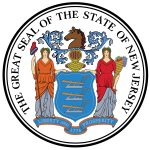 |
The 1868 New Jersey gubernatorial election was held on November 3, 1868. Democratic nominee Theodore Fitz Randolph defeated Republican nominee John Insley Blair with 51.42% of the vote.
| |||||||||||||||||
| |||||||||||||||||
| |||||||||||||||||
| Elections in New Jersey |
|---|
 |
The 1868 New Jersey gubernatorial election was held on November 3, 1868. Democratic nominee Theodore Fitz Randolph defeated Republican nominee John Insley Blair with 51.42% of the vote.
| Party | Candidate | Votes | % | ±% | |
|---|---|---|---|---|---|
| Democratic | Theodore Fitz Randolph | 83,955 | 51.42% | ||
| Republican | John Insley Blair | 79,333 | 48.58% | ||
| Total votes | 163,288 | ||||
| Democratic gain from Republican | Swing | ||||
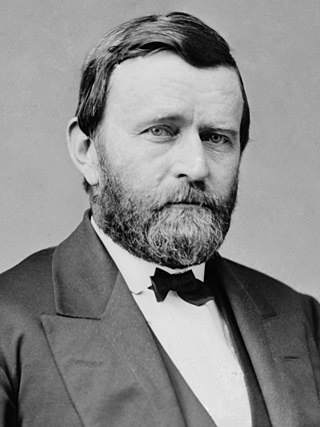
The 1868 United States presidential election was the 21st quadrennial presidential election, held on Tuesday, November 3, 1868. In the first election of the Reconstruction Era, Republican nominee Ulysses S. Grant defeated Horatio Seymour of the Democratic Party. It was the first presidential election to take place after the conclusion of the American Civil War and the abolition of slavery. It was the first election in which African Americans could vote in the reconstructed Southern states, in accordance with the First Reconstruction Act.

The 1904 United States presidential election was the 30th quadrennial presidential election, held on Tuesday, November 8, 1904. Incumbent Republican President Theodore Roosevelt defeated the conservative Democratic nominee, Alton B. Parker. Roosevelt's victory made him the first president who ascended to the presidency upon the death of his predecessor to win a full term in his own right. Roosevelt was 46 after he was elected to a full term and his second inauguration took place on March 4, 1905.
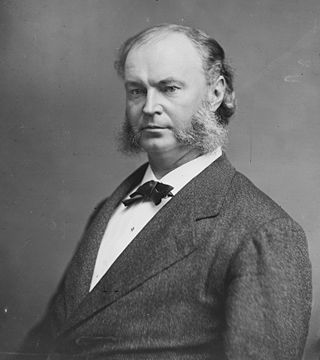
Theodore Fitz Randolph was an American attorney, businessman, and politician who served as the 22nd governor of New Jersey from 1869 to 1872 and represented the state in the United States Senate from 1875 to 1881. He was the son of U.S. Representative James F. Randolph.
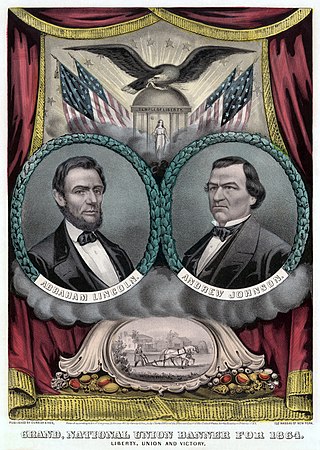
The National Union Party was the name used by the Republican Party and elements of other parties for the national ticket in the 1864 presidential election during the Civil War. Most state Republican parties did not change their name. The name was used to attract War Democrats, border state voters, and Unconditional Unionist, and Unionist Party members who might otherwise have not voted for Republicans. The National Union Party nominated incumbent Republican President Abraham Lincoln of Illinois and Democrat Andrew Johnson of Tennessee for Vice President. They won the Electoral College 212–21.

The 1906 New York state election was held on November 6, 1906, to elect the governor, the lieutenant governor, the Secretary of State, the state comptroller, the attorney general, the state treasurer and the state engineer, as well as all members of the New York State Assembly and the New York State Senate.

The 1932 United States presidential election in California took place on November 8, 1932 as part of the 1932 United States presidential election. State voters chose 22 representatives, or electors, to the Electoral College, who voted for president and vice president.

The 1912 United States presidential election in California took place on November 5, 1912 as part of the 1912 United States presidential election. State voters chose 13 representatives, or electors, to the Electoral College, who voted for president and vice president.

The 1936 United States presidential election in Pennsylvania took place on November 3, 1936 as part of the 1936 United States presidential election. Voters chose 36 representatives, or electors to the Electoral College, who voted for president and vice president.

The 1904 United States presidential election in Pennsylvania took place on November 8, 1904 as part of the 1904 United States presidential election. Voters chose 34 representatives, or electors to the Electoral College, who voted for president and vice president.

The 1856 United States presidential election in Pennsylvania took place on November 4, 1856, as part of the 1856 United States presidential election. Voters chose 27 representatives, or electors to the Electoral College, who voted for president and vice president.

The 1916 United States presidential election in Montana took place on November 7, 1916 a part of the 1916 United States presidential election. Voters chose four representatives, or electors to the Electoral College, who voted for president and vice president.

The 1916 United States presidential election in New York took place on November 7, 1916. All contemporary 48 states were part of the 1916 United States presidential election. Voters chose 45 electors to the Electoral College, which selected the president and vice president.

The 1892 New Jersey gubernatorial election was held on November 8, 1892. Democratic nominee George Theodore Werts defeated Republican nominee John Kean with 49.65% of the vote.

The 1888 United States presidential election in New Hampshire took place on November 6, 1888, as part of the 1888 United States presidential election. Voters chose four representatives, or electors to the Electoral College, who voted for president and vice president.

The 1972 United States presidential election in Nevada took place on November 7, 1972. All fifty states and the District of Columbia were part of the 1972 United States presidential election. State voters chose three electors to the Electoral College, who voted for president and vice president.

The 1908 United States presidential election in North Carolina took place on November 3, 1908. All contemporary 46 states were part of the 1908 United States presidential election. North Carolina voters chose 12 electors to the Electoral College, which selected the president and vice president.

In 1868, the Democrats nominated former New York Governor Horatio Seymour for President and Francis Preston Blair Jr. for Vice President. The Seymour-Blair ticket ran on a platform which supported national reconciliation and states' rights, opposed Reconstruction, and opposed both Black equality and Black suffrage. Meanwhile, the Republican presidential ticket led by General Ulysses S. Grant benefited from Grant's status as a war hero and ran on a pro-Reconstruction platform. Ultimately, the Seymour-Blair ticket ended up losing to the Republican ticket of General Ulysses S. Grant and House Speaker Schuyler Colfax in the 1868 U.S. presidential election.

The 1860 Michigan gubernatorial election was held on November 6, 1860. Republican nominee Austin Blair defeated Democratic nominee John S. Barry with 56.69% of the vote.
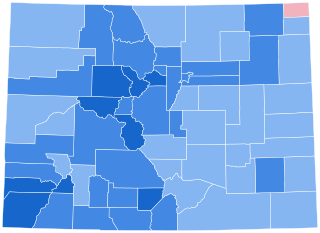
The 1916 United States presidential election in Colorado took place on November 7, 1916. All contemporary forty-eight states were part of the 1916 United States presidential election. State voters chose six electors to the Electoral College, who voted for president and vice president.

The 1944 Tennessee gubernatorial election was held on November 7, 1944. Democratic nominee Jim Nance McCord defeated Republican nominee John W. Kilgo with 62.5% of the vote.